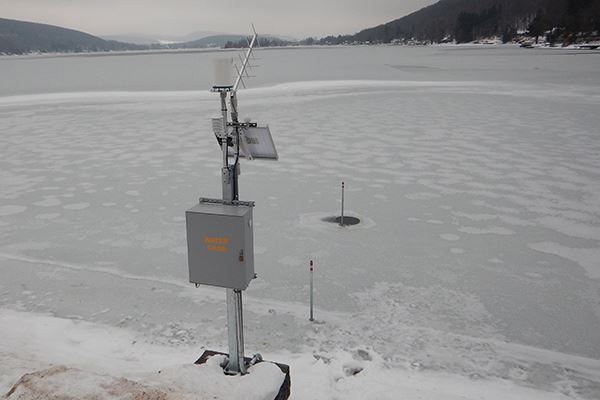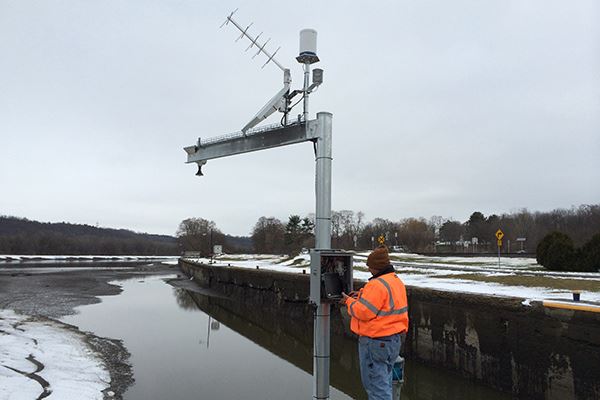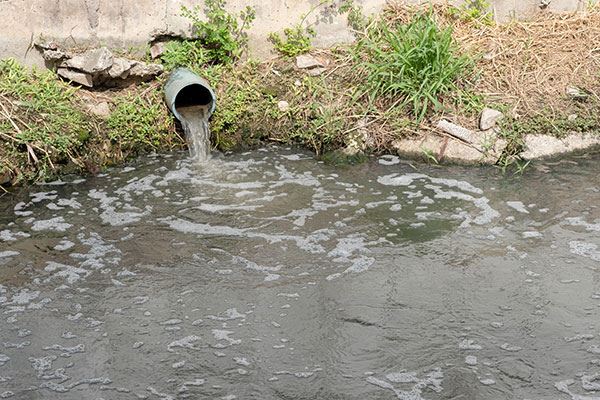Why Would I Need to Measure Temperature When Monitoring Water Level?
The short answer is that you don’t need to measure temperature in addition to water level if you really don’t want to. However, there are a lot of benefits to doing so, which we will go through here.
Water temperature is a very simple to measure water quality parameter but can provide an extremely large amount of important information. Some water level sensors have an integrated thermistor inside them, such as the H-3123 submersible pressure transducer, but most water level sensors will require the addition of an accessory thermistor if you want to collect temperature.
There are versions of temperature sensors that also allow for the collection of other water quality parameters as well, such as the ProSwap Logger and EXO sondes; these instruments can have water level sensors built-in, which means we chose an instrument with water temperature as our primary focus and depth or water level as the bonus! This definitely did not answer the question as to why you would want to do this, but starting out with knowing some equipment options is never a bad thing.

1) Cold Weather and Water is Hard on Instruments
Have you ever measured water level in the cold of winter with a non-submersible pressure transducer and all of a sudden, your readings start to get a little erratic? This could be due to the effects of ice buildup inside your orifice tubing. Orifice tubing might be part of your sensor if it is a vented sensor, the advantage of which is that it affords automatic compensation for barometric pressure. Recall from this blog post, On The Level | Groundwater Measurement at High Altitude, that barometric pressure, as well as the salinity of the water, can affect water level readings. We'll talk a little more about salinity below.
If you know what the temperature of the water is, you likely have a better idea of the air temperature as well and can prepare for equipment maintenance that may need to take place for the safety of your sensors. Similarly, you would not want to leave your submersible pressure transducer in a body of water where it could be frozen – the transducer itself could bust, leaving you with a costly repair before the next monitoring season.
Outside of the effects on instrumentation, the water itself will be going through changes when it is cold in particular. As we all know, at 0°C, water will go from liquid to solid (ignore conductivity and its effects on solidifying water here, please!). Ice has a different density, of course, and the presence of ice above a water level sensor will affect the pressure reading causing inaccurate results.
Radars will also be affected by ice because they cannot actually get to the water anymore – the water level may appear flat for a period of time. Once the ice begins to break up and chunks start to float downstream, the water level data from radars may look very erratic as the microwaves bounce off of these random pieces until all of the ice is gone.

2) Measurements of Other Water Quality Parameter Changes
Didn’t we only want to talk about temperature and Reason #2 is now talking about other things too?? This is getting complicated, right?! Well, it’s true. Water temperature is a very good gauge for how other parameters are going to be changing in a system as well. Dissolved oxygen, pH, and conductivity are three parameters that are dependent on temperature and each will be discussed briefly here.
The higher the temperature, the lower the neutral value of pH. What does this mean? At room temperature, neutral water will have a pH of 7.00 standard units. However, as the temperature of the water is increased, the neutral pH of the water will change as more hydrogen ions will be incorporated into the water over hydroxide ions. If you have a pH buffer that you use to calibrate a meter, you will notice that as these aqueous solutions get warmer, the buffer “becomes more acidic.” It is not really becoming more acidic – the neutral value for that buffer is simply changing with temperature change.
Dissolved oxygen is also another parameter that is temperature dependent and the higher the temperature, the lower the saturation concentration of oxygen in water. Any deviations in temperature will accompany expected changes in these parameters as well. If we think of seasons, colder water in the winter will store a higher concentration of dissolved oxygen than will be found in a warm water body in the summer.
Lastly, conductivity is dependent on temperature, which is why many instruments will compensate for temperature with a parameter called “specific conductivity.” Specific conductivity accounts for temperature in the calibration process and also during sensor deployments so that values can be compared across a longer time period, and between sensors. However, in general, as temperature increases, non-compensated conductivity will increase.

3) Monitoring for Changes in the Environment
While water level alone can show that something is entering a body of water, this doesn’t tell the entire story. If the water is warmer or cooler, that can help source where an influent is coming from.
For example, let’s say our site is located downstream of a dam that releases from the bottom of a lake and an industrial plant that uses water for cooling. If the water level at the river gage increases and there is a corresponding decrease in temperature, we can assume that the source of water is the dam since the water at the bottom of the reservoir is likely to be cooler than the water at the top, which would likely match our hypothetical river. However, if the water level increases and the water temperature also increases, we could possibly make the assumption that the plant is releasing water into the river.
Temperature can also be indicative of pollutants, like sewage, entering water. During stormflow in urban areas in the summer, it is also typical that an increase in temperature occurs as runoff from heated impervious areas washes into the basin – yet another indicator of pollution. Finally, temperature can be indicative of changing aquatic environments as a whole. Forest fires can be extremely devastating to an ecosystem and knowing what temperatures of a river before and after a fire are can actually help determine the impacts that have taken place, independently of water level.
There are many more reasons to measure water temperature in conjunction with water level, but these three are a really good starting point for discussion! If you would like to add water temperature and water level sensors to your monitoring site, please feel free to reach out and let us help you choose the best solution for your project.
